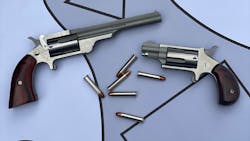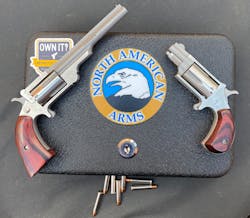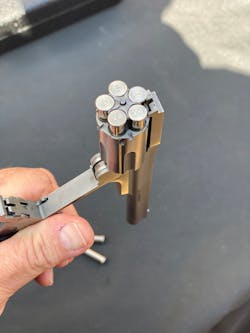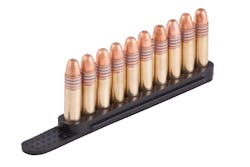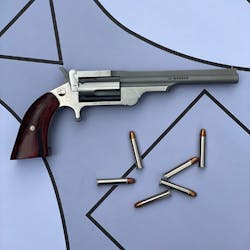Small & Effective
For the LET June/July Firearms Tactics column, I tested a North American Arms (NAA) Ranger Break Top II in .22 magnum. The Ranger II is different than other NAA Mini Revolver models. Instead of having to remove the cylinder and practically disassemble the firearm in order to reload it, this one is a top break, which means that the frame hinges in front of the cylinder, allowing for a quick five-shot reload.
I had NAA send me the four-inch barrel version, simply because it is much easier to import into California. For law enforcement backup, I recommend the 2.5” barrel version (NAA-22MC-R250). It is easier to carry and comes with a .22 magnum and .22 long rifle cylinder, which allows cheaper practice sessions. The MSRP for the 2.5” model is $639.
"The Ranger II is the quickest loading revolver in the North American Arms lineup."
The break top revolver style of the Ranger II is not new, but the company’s adaptation is refreshing and modern. From about 1870 to 1915, Smith & Wesson produced the Model 3 Revolver, a break top originally chambered in .44 S&W and .44 Russian. The most well-known version was the Schofield, a modified design by Union Major George W. Schofield of the 10th Cavalry. Schofield wrote to Smith & Wesson with some adaptations of the Model 3. Smith & Wesson made the changes, possibly in the interest of obtaining a military contract. Schofield recognized the utility of having the break top action during a Cavalry charge. The S&W Model 3 was designed, produced, and adopted, for one major purpose: the speed at which it can be reloaded and brought back into action. It was reported that some soldiers got fairly good at using this revolver, reloading it on the fly without looking at that what they were doing.
It goes ‘snick’
Have you ever closed the door on one of those expensive luxury cars? Middle class cars go “klunk.” Luxury cars go “snick.” The Ranger II goes “snick” when you work it.
It’s no secret that I am an NAA fan, and I am unabashed about this full disclosure. However, it is quite easy for me to substantiate my position.
NAA uses high quality stainless steel. I keep an NAA gun “at the ready” in an area that is subject to extremely high humidity. The ammo in it tends to tarnish after a few weeks, despite the fact that I clean the gun often. When I travel somewhere, I usually swap this gun for another small gun, which is blued steel. Then, I take the NAA with me. The first time I did this, I returned after a week and had to polish out the rust spots on the other (non NAA) gun I left home. My NAA gun has never discolored, even after several years of high humidity torture.
What’s worse on a gun, body sweat or body oils? The advantage goes to NAA products. The finish on my Ranger II is perfect. Even in areas where one has to disassemble the gun to see, there are no spurious tool marks. Parts are melted into the finish, and everything operates consistently.
The Ranger II disassembles without any tools. That is, the cylinder pulls completely off the spindle, making it easy to clean and inspect. Powder residue and fouling don’t stick to the stainless very well, and no common solvent will etch or stain it.
My Backup for EDC
The gun I carry running and cycling, has always been my NAA .22M, the old version which requires the cylinder to come away from the frame to reload. I have switched to the NAA Ranger II. My only regret is that I didn’t get the .22LR cylinder for range time. This is an amazing gun, and a great law enforcement tool.
An effective mouse gun
NAA has been around since 1972. They are well-known for manufacturing small caliber single action pocket revolvers and pistols. NAA has a reputation for building guns at an extremely high quality at a reasonable price.
Within the first year of my being sworn in, I have carried a NAA product on and off-duty. Of all the guns I have carried over the years, at least one of them has been a NAA revolver, usually a .22 magnum, but I have several other NAA guns. They hold up under extreme temperatures and conditions, including saltwater, heavy moisture, dirty and dusty ranges, and questionable ammo. I carry an NAA everywhere, especially where discretion is required or when organizations ignore what is in the constitution. I have never had an NAA product fail on me. On the range, I practice with my NAA revolver almost every session, regardless of whatever else I am practicing with that day.
NAA has a reputation of standing behind the product 100%. I’m afraid that I have absolutely no experience with exercising their warranty, so we will have to go with what others say about the products.
Quick reload
I was able to break into a cadence on shooting and reloading this gun. Firing all five rounds from a strong hand grip, reloading begins with unlatching the gun. The non-firing hand reaches over the top of the barrel and eases the barrel open. At this time, the barrel tilts down and the shooter completely transitions the gun into the non-firing hand. Tilting the gun forward so the barrel points down diagonally, the shooter allows the grip portion of the gun to drop, extending the star extractor fully. With the firing hand, the shooter grabs the spent cartridges and sweeps them away. Pointing the barrel straight down, with the action still fully open in the non-firing hand and fingers of the non-shooting hand supporting the grip section of the revolver, the shooter loads the chambers. Using the non-firing hand, the shooter pinches the cylinder between the non-firing thumb and pointer finger, and passes the gun into the shooting hand while simultaneously closing the action. Shooter assumes a full two-handed grip.
I know that the explanation on how to reload this firearm sounds complicated, but it is approximately five seconds from last cartridge fired to fully loaded gun on the range. I have not mastered “not looking at the gun” while reloading, but that is coming.
New ammunition makes it a viable option
Only a few years ago, I would have told you that the .22 magnum was ineffective in a pistol. Now, it is safe to say that there are cartridges designed for short barrel guns, and their performance is exceptional. I have personally tested both of the most effective cartridges in the business for short barrel .22 magnums, the Hornady .22 WMR 45 gr FTX Critical Defense, and the Speer Gold Dot Short Barrel Personal Protection Rimfire .22 WMR 40 gr.
The Ranger II comes with a rear notch sight cut into the cylinder latching mechanism. The front sight is a post, similar in appearance to a shotgun bead sight. I personally prefer the beefy ones, like the ones on the NAA Mini Master models, but these will do.
Please do not dismiss this, or any NAA gun, with “this is a belly gun” and think that it was not designed for sighted fire. I am confident with all of my NAA guns, and practice head shots out to seven yards. The Ranger II is up to this, regardless of the barrel length.
About the Author

Officer Lindsey Bertomen (ret.), Contributing Editor
Lindsey Bertomen is a retired police officer and retired military small arms trainer. He teaches criminal justice at Hartnell College in Salinas, California, where serves as a POST administrator and firearms instructor. He also teaches civilian firearms classes, enjoys fly fishing, martial arts, and mountain biking. His articles have appeared in print and online for over two decades.
